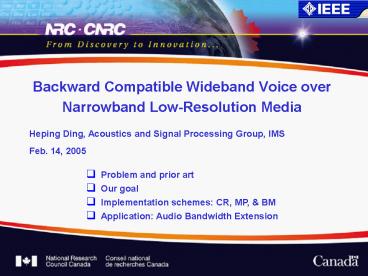Backward Compatible Wideband Voice over Narrowband LowResolution Media - PowerPoint PPT Presentation
1 / 13
Title:
Backward Compatible Wideband Voice over Narrowband LowResolution Media
Description:
has a narrow band (NB, 300 - 3400 Hz), used up by voice ... 1. Original wide-band (16-bit linear, Fs = 16 kHz) 2. Narrow-band, up to 3.4 kHz (8-bit m-law, Fs = 8 kHz) ... – PowerPoint PPT presentation
Number of Views:42
Avg rating:3.0/5.0
Title: Backward Compatible Wideband Voice over Narrowband LowResolution Media
1
Backward Compatible Wideband Voice over
Narrowband Low-Resolution Media
Heping Ding, Acoustics and Signal Processing
Group, IMS Feb. 14, 2005
- Problem and prior art
- Our goal
- Implementation schemes CR, MP, BM
- Application Audio Bandwidth Extension
2
Problem and Prior Art
- Standard telephone network
- is meant to transmit toll-quality (barely
acceptable) voice only - has a narrow band (NB, 300 - 3400 Hz), used up by
voice - has little room in bandwidth/capacity extension
in order to incorporate voice quality improvement
and/or additional services
3
Problem and Prior Art
- Existing ways of extending the capacity
- Time- or frequency-division, e.g., call waiting,
CLID - Simple and widely used
- Causes voice interruption or degradation
- Limited capacity
- Vocoding, e.g., voice audio coding/decoding
schemes - Complicated
- Transmits digital signals, not compatible with
POTS - SVD, e.g., dial-up modems
- Needs modem hardware - complicated and costly
- Signals transmitted not compatible with POTS
POTS plain ordinary telephone set
4
Our Goal
- Wanted a capacity extending scheme that
- is simple, without the need for special hardware,
e.g., a modem - is compatible with existing end-user equipment,
i.e., a POTS should still be able to access the
basic voice service - allows terminals equipped with the decoding
mechanism to access the added payload
POTS plain ordinary telephone set
5
Implementation Scheme 1 CR
- Component Replacement (CR)
Original NB voice spectrum with perceptual mask
shown
f (Hz)
NB
300
3400
6
Implementation Scheme 2 MP
- Magnitude Perturbation (MP)
Original NB signal spectrum
f (Hz)
NB
300
3400
7
Application Audio Bandwidth Extension
- Bandwidth extension beyond conventional NB (300 -
3400 Hz) can provide significant improvements in
intelligibility and voice quality - Upper band (UB)
- Lower band (LB)
- However, we cant extend the physical bandwidth
of the existing telephone network beyond NB - No sweeteners
8
Application Audio Bandwidth Extension
Example 1 Using magnitude perturbation
f
Transmitter
NB
Determine perceptual mask
Perturb NB magnitudes to embed
Network
Band split
LUB
Retain only those above mask
9
Implementation Scheme 3 BM
Bit Manipulation (BM)
- Suitable for digital systems, e.g., linear or
G.711 formatted data - a m-law data sample
- Certain M0 can be manipulated without seriously
harming audio - Challenges
- Minimize information amount (No. of bits) to
represent UB - Maximize capacity of hidden channel
10
Application Audio Bandwidth Extension
Example 2 Using coding-assisted bit manipulation
- transmitter
- Need only part of voice encoder, for spectral
shape, e.g., LSP coefficients - Less than 0.3 bit per sample is needed to
transmit UB information - Embedding is done in a least audible way by
modifying an LSB every 3 or 4 samples
11
Application Audio Bandwidth Extension
Example 2 Using coding-assisted bit manipulation
- receiver
- Fast converging adaptive LPC analysis on received
NB signal to derive excitation - Need only part of voice decoder, for implementing
all-pole model
12
Application Audio Bandwidth Extension
Example 2 Using coding-assisted bit manipulation
- demo
1. Original wide-band (16-bit linear, Fs 16
kHz) 2. Narrow-band, up to 3.4 kHz (8-bit
m-law, Fs 8 kHz) 3. Narrow-band
with upper-band information embedded
(8-bit m-law, Fs 8 kHz) 4.
Restored wide-band (16-bit linear, Fs 16 kHz)
13
Application Audio Bandwidth Extension
Possible ways of implementation
NB telephone network
Encoder Decoder































